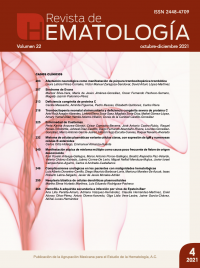Atypical manifestation of multiple myeloma as a little frequent cause of unknown origin fever.
Rev Hematol Mex. 2021; 22 (4): 240-245. https://doi.org/10.24245/rev_hematol.v22i4.7103
Itzel Yoselin Arteaga-Gallegos, Marco Antonio Ponce-Gallegos, Beatriz Alejandra Paz-Velarde, Valeria Chávez-Estrada, Juárez Correa-De León, Miguel Neftalí Mendoza-Mujica, Javier Israel Campechano-Aguirre, Carlos A Andrade-Castellanos
Servicio de Medicina Interna, Nuevo Hospital Civil de Guadalajara Dr. Juan I Menchaca, Jalisco, México.
Resumen
ANTECEDENTES: El mieloma múltiple es una neoplasia maligna de células plasmáticas que representa alrededor del 10% de las neoplasias hematológicas. Las manifestaciones clínicas más frecuentes son anemia, hipercalcemia, insuficiencia renal y lesiones óseas líticas. La fiebre suele ser una manifestación muy rara.
CASO CLÍNICO: Paciente femenina de 47 años de edad con antecedente de fiebre de hasta 40°C y fatiga de un año de evolución en quien, al ser hospitalizada, se evidenció anemia normocítica normocrómica con incompatibilidad a todos los grupos sanguíneos. Se descartaron causas infecciosas por radiografía de tórax, tomografía axial computada toraco-abdominal, hemocultivos y urocultivo, baciloscopias y GeneXpert MTB/RIF, todos resultaron negativos. Tras el abordaje de la anemia se realizó un aspirado de médula ósea en el que se encontró más del 80% de celularidad a base de células plasmáticas, así como eritrocitos apilados y fondo proteáceo, con lo que se estableció el diagnóstico de mieloma múltiple. La paciente nunca tuvo hipercalcemia, la función renal estuvo conservada y no se evidenciaron lesiones óseas líticas.
CONCLUSIONES: La fiebre es un síntoma poco frecuente en pacientes con diagnóstico de mieloma múltiple. Por tanto, ante un paciente con fiebre de origen desconocido, el mieloma múltiple es un diagnóstico que no se sospecha de forma inicial y la sospecha baja aún más cuando el cuadro clínico ocurre de forma atípica o inespecífica, como el caso comunicado. Sin embargo, al ser una neoplasia hematológica, formará parte de los diagnósticos diferenciales.
PALABRAS CLAVE: Mieloma múltiple; fiebre de origen desconocido; anemia; hipercalcemia; células plasmáticas.
Abstract
BACKGROUND: Multiple myeloma is a malignant neoplasm of plasma cells that represents about 10% of hematological neoplasms. The most frequent clinical manifestations are anemia, hypercalcemia, renal failure, and lytic bone lesions. Fever is usually a very rare manifestation.
CLINICAL CASE: A female patient with a history of fever of up to 40°C and fatigue of one year of duration who, when hospitalized, revealed normochromic normocytic anemia with incompatibility to all blood groups. Infectious causes were ruled out by chest X-ray, thoraco-abdominal computed tomography, blood and urine cultures, baciloscopies and GeneXpert, all of which were negative. After addressing the anemia, a bone marrow aspirate was performed, finding more than 80% cellularity based on plasma cells, as well as stacked erythrocytes and protease background, stablishing the diagnosis of multiple myeloma. The patient never had hypercalcemia, renal function was preserved, and lytic bone lesions were not evident.
CONCLUSIONS: Fever is a rare symptom in patients diagnosed with multiple myeloma. Therefore, in a patient with a diagnosis of fever of unknown origin multiple myeloma turns out to be a diagnosis that is not initially suspected, and it lowers the suspicion even more when the clinical picture is presented in an atypical or nonspecific way, as in the case of our patient. However, as it is a hematological neoplasm, it will be part of the differential diagnoses.
KEYWORDS: Multiple myeloma; Fever of unknown origin; Anemia; Hypercalcemia; Plasma cells.
Recibido: noviembre 2021
Aceptado: enero 2022
Este artículo debe citarse como: Arteaga-Gallegos IY, Ponce-Gallegos MA, Paz-Velarde BA, Chávez-Estrada V, Correa-De León J, Mendoza-Mujica MN, Campechano-Aguirre JI, Andrade-Castellanos CA. Manifestación atípica de mieloma múltiple como causa poco frecuente de fiebre de origen desconocido. Hematol Méx 2021; 22 (4): 240-245.

